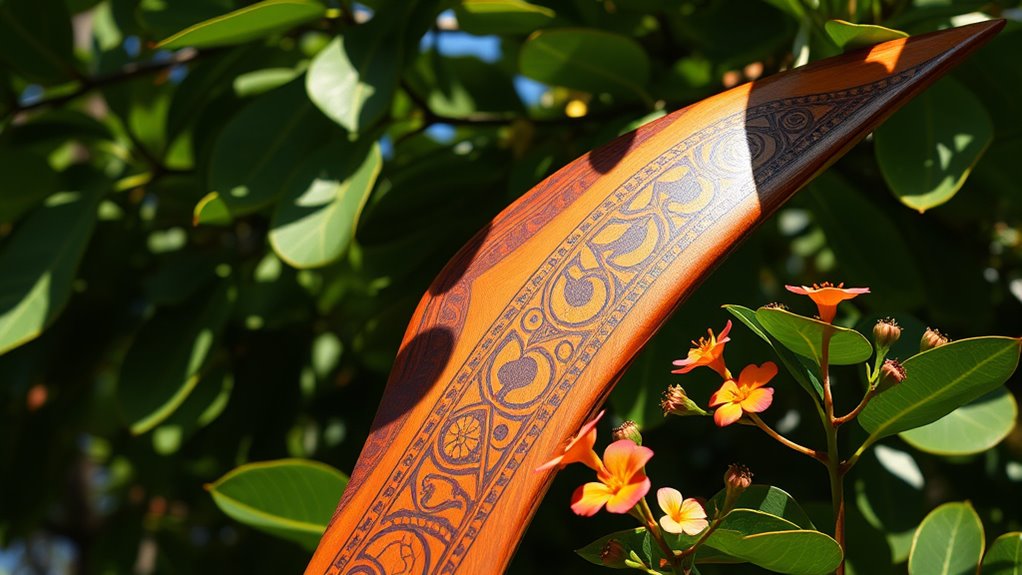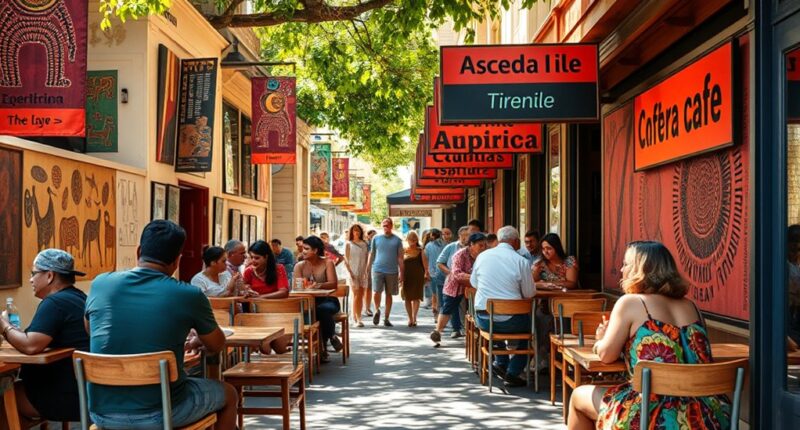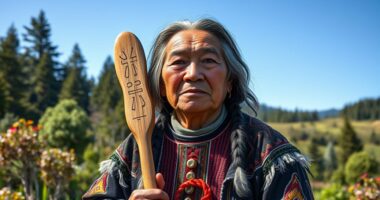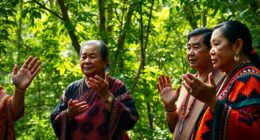You’ll find that many Australian English words come from Aboriginal languages, reflecting the country’s rich indigenous heritage. Words like “kangaroo,” “boomerang,” and “wallaby” entered English because they had no direct equivalents and described local flora, fauna, and cultural practices. These borrowed terms reveal a deep connection to the landscape and indigenous traditions. To discover more about how these words shape Australian identity and language, keep exploring beyond the surface.
Key Takeaways
- Many Australian English words originate from Aboriginal languages, reflecting indigenous influence on vocabulary.
- Words like “kangaroo,” “boomerang,” and “wallaby” are borrowed directly from Aboriginal languages.
- These loanwords often retain original pronunciation and meanings, emphasizing cultural and linguistic connections.
- Aboriginal loanwords have become integral to everyday Australian speech, symbolizing cultural identity.
- The incorporation of indigenous terms highlights the lasting impact of Aboriginal culture on Australian language and heritage.

Have you ever wondered where many Australian words come from? One of the most significant sources is indigenous languages, especially Aboriginal vocabulary. When settlers arrived, they encountered a rich tapestry of linguistic traditions that had been developing for thousands of years. As a result, Australian English absorbed numerous words directly from Aboriginal languages through a process known as linguistic borrowing. This borrowing wasn’t just about adding new words; it was a way for settlers to describe the landscape, flora, fauna, and cultural practices they encountered, often for which no existing English equivalent existed.
Many of these borrowed words became part of everyday speech, especially in regions where Aboriginal communities were more prominent. Terms like “kangaroo,” “boomerang,” and “wallaby” are prime examples. These words stand out because they entered English directly from Aboriginal languages, preserving their original sounds and meanings. The word “kangaroo,” for instance, is believed to come from the Guugu Yimithirr language, spoken in Queensland. It’s a perfect example of linguistic borrowing, where a word from indigenous vocabulary seamlessly integrated into the colonial lexicon, often with slight pronunciation adjustments to fit English phonetics.
Many Australian words like kangaroo and boomerang come directly from Aboriginal languages, preserving their original sounds and meanings.
This exchange of words wasn’t just one-sided. Indigenous communities also adopted some English terms, blending them into their own languages, creating a dynamic linguistic landscape. But in terms of Australian English, these borrowed words reveal a deep connection to the land and its original inhabitants. They serve as linguistic markers of Australia’s unique cultural identity, a reflection of the enduring influence of Aboriginal languages.
Over time, many of these words have become so common that they’re no longer seen as loanwords but as native parts of Australian English. They’re used daily, in casual conversations, media, and even in official contexts. The process of linguistic borrowing allowed English speakers to describe unfamiliar objects and concepts accurately, enriching the language and providing it with a distinctive Australian flavor. It also helped preserve aspects of Aboriginal culture, as these words often encapsulate unique cultural practices or natural features specific to the continent.
Furthermore, understanding these borrowed words offers insights into the linguistic history of Australia and how contact with indigenous communities shaped the evolution of the language. These words are more than just vocabulary—they are living symbols of Australia’s indigenous heritage, continually shaping the way Australians communicate and connect with their environment. The impact of this linguistic borrowing reminds us that language evolves through contact and exchange, creating a richer, more diverse way to tell the stories of a land and its people.
Frequently Asked Questions
How Have Indigenous Languages Evolved Alongside Australian English?
You see indigenous languages have evolved alongside Australian English through cultural exchange and language adaptation. As you interact with Indigenous communities, you notice new words and expressions becoming part of everyday speech. This process enriches Australian English, reflecting the diverse cultural influences. You might find that some indigenous terms are used to describe local flora, fauna, or customs, showing how language adapts and grows through ongoing cultural exchange.
Are All Indigenous Loanwords Still in Common Use Today?
You might think all indigenous loanwords are everywhere, but that’s not true. Not all are still in common use today, though many hold deep cultural significance. Some words have been retained through linguistic retention, keeping native languages alive within everyday speech. Others fade away, lost to time. So, while some indigenous words still shine brightly in Australian English, many have quietly slipped into history, holding onto their cultural importance.
Which Indigenous Language Contributed the Most Loanwords to Australian English?
You’ll find that the most significant indigenous language contributing to Australian English is the Aboriginal vocabulary from various groups, especially the Dharug and Warlpiri languages. These languages have influenced Australian slang and place names, reflecting their cultural importance. Their dominance in certain regions means you’ll notice their words more often, shaping everyday language and preserving their legacy in Australian vocabulary.
How Do Indigenous Loanwords Influence Australian Slang and Idioms?
You’ll notice that indigenous loanwords deeply influence Australian slang and idioms, shaping cultural identity and enriching language. Words like “arvo” for afternoon or “bogan” reflect linguistic adaptation, connecting you to Australia’s Indigenous heritage. These terms often carry cultural significance and help express local identity, making conversations more authentic and rooted in history. By using these words, you participate in preserving and celebrating Indigenous contributions to Australian culture.
Are There Efforts to Preserve Indigenous Languages Through These Loanwords?
Think of loanwords as bridges connecting you to Indigenous cultures. Yes, efforts for cultural preservation and language revitalization actively include indigenous words in everyday speech. By adopting these terms, you help keep languages alive and honor their significance. These loanwords serve as living symbols of resilience, ensuring that Indigenous languages remain vibrant and relevant, fostering a deeper understanding and respect for Australia’s rich cultural tapestry.
Conclusion
As you explore Australian English, you realize it’s like a tapestry woven with threads from the land’s first peoples. Imagine stepping into a bustling market where every word, like “kangaroo” or “boomerang,” tells a story of culture and history. These loanwords aren’t just vocabulary; they’re living echoes of Indigenous traditions. By embracing them, you connect more deeply with Australia’s rich heritage, making your language journey truly meaningful and rooted in the land’s ancient stories.
Mary is a passionate writer who brings creativity and a fresh perspective to our team. Her words have the power to captivate and inspire, making her an essential contributor to our content. Mary’s commitment to storytelling and dedication to promoting Indigenous culture ensures that her work touches the hearts of our readers. We’re fortunate to have her as part of our team.









